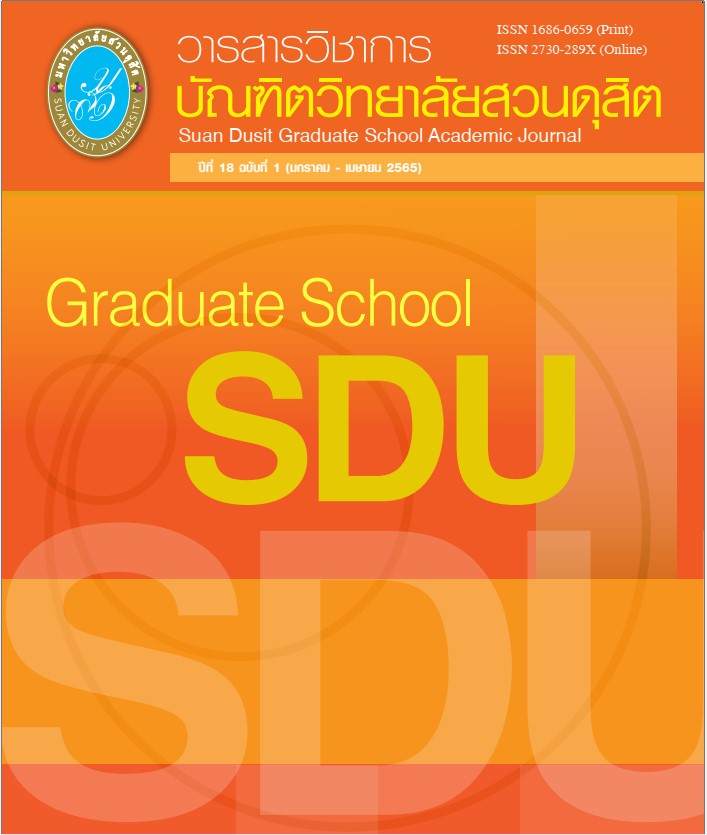The Development of Flipped Classroom and the Cooperative Learning Model in Basic Counting Principles for Mathayomsuksa 4 Students
Keywords:
Flipped Classroom, The Cooperative Learning Model, Academic AchievementAbstract
The research aimed to develop the flipped classroom and the cooperative learning model in Basic Counting Principles for Mathayomsuksa 4 students, which was the experimental research. The purposes of this study were: 1. to create and evaluate the efficiency of learning activities at the level 80/80, 2. to compare students' academic achievement before and after learning activities. The sample consisted of 36 students of Mathayomsuksa 4, academic year 2021. 3. To study students’ satisfaction towards the learning activities. Research tools consisted of plan for classroom learning activities development of flipped classroom and the cooperative learning model, achievement test with the difficulty value between 0.31 - 0.74, the discrimination index between 0.31 - 0.99 and the reliability coefficient of 0.73 and students’ satisfaction evaluation form. The statistical data analyses were mean, S.D., percentage and t-test dependent sample. The results of the study were as follows: 1. Learning activities were appropriate at the high level "(" ¯("X" ) " = 4.49,S.D.=0.69)" and the results of the efficiency of learning activities were found to be effective at 83.05/81.83, which was consistent with the 80/80 criteria. 2. The comparison of academic achievement indicated that academic achievement after engaging student learning activities was significantly higher than before the learning activity at the statistical significance level of .05 3. Overall, students were very satisfied with the learning activities at the high level "(" ¯("X" ) "=3.80,S.D.=0.77)" .
References
กระทรวงศึกษาธิการ. (2560). ตัวชี้วัดและสาระการเรียนรู้แกนกลางกลุ่มสาระการเรียนรู้คณิตศาสตร์ (ฉบับปรับปรุง พ.ศ.2560) ตามหลักสูตรแกนกลางการศึกษาขั้นพื้นฐาน พุทธศักราช 2551. กรุงเทพฯ: โรงพิมพ์ชุมนุมสหกรณ์การเกษตรแห่งประเทศไทย.
ชนาธิป พรกุล. (2544). จัดการเรียนการสอน การจัดการเรียนการสอนแบบผู้เรียนเป็นศูนย์กลาง. วารสารวิชาการ. 4 (9), 2-7.
ชัยยงค์ พรหมวงศ์. (2556). การทดสอบประสิทธิภาพสื่อหรือชุดการสอน. วารสารศิลปากรศึกษาศาสตร์วิจัย, 5 (1), 7-20.
ชุลีพร ตั้งล้ำเลิศ. (2558). ผลการจัดกิจกรรมการเรียนรู้ตามแนวคิดห้องเรียนกลับด้านที่มีต่อผลสัมฤทธิ์ทางการเรียนรายวิชาเคมี เรื่องอัตราการเกิดปฏิกิริยาเคมีของนักเรียนระดับชั้นมัธยมศึกษาปี ที่ 5 สายการเรียนวิทยาศาสตร์ ที่มีกิจกรรมนอกห้องเรียนโรงเรียนอัสสัมชัญสมุทรปราการ. วิทยานิพนธ์ ศึกษาศาสตรมหาบัณฑิต คณะครุศาสตร์ มหาวิทยาลัยสุโขทัยธรรมาธิราช.
บุญยงค์ ตาลวิลาส. (2562). การพัฒนากิจกรรมการเรียนรู้คณิตศาสตร์ตามแนวคิดห้องเรียนกลับด้าน โดยใช้รูปแบบการสอนแบบร่วมมือแบบ TAI เรื่อง เรขาคณิตวิเคราะห์ ชั้นมัธยมศึกษาปีที่ 4. วิทยานิพนธ์ คุรุศาสตรมหาบัณฑิต คณะครุศาสตร์ มหาวิทยาลัยราชภัฏสกลนคร.
ทิศนา แขมมณี. (2553). ศาสตร์การสอน องค์ความรู้เพื่อการจัดกระบวนการเรียนรู้ที่มีประสิทธิภาพ. (พิมพ์ครั้งที่ 12) กรุงเทพฯ: สุทธาการพิมพ์.
ธนภรณ์ กาญจนพันธ์. (2559). ผลการจัดการเรียนรู้แบบห้องเรียนกลับทางที่มีต่อผลสัมฤทธิ์ทางการเรียนวิชาชีววิทยา การกำกับตนเอง และความพึงพอใจต่อการจัดการเรียนรู้ของนักเรียนชั้นมัธยมศึกษาปีที่ 5. วิทยานิพนธ์การศึกษามหาบัณฑิต คณะศึกษาศาสตร์ มหาวิทยาลัยสงขลานครินทร.
ยุภาพร ด้วงโต้ด. (2561). การจัดการเรียนรู้โดยใช้ห้องเรียนกลับด้าน เพื่อพัฒนาผลสัมฤทธิ์ทางการเรียนรายวิชาคณิตศาสตร์ สำหรับนักเรียนชั้นมัธยมศึกษาปีที่ 3. วิทยานิพนธ์ศึกษาศาสตรมหาบัณฑิต คณะครุศาสตร์อุตสาหกรรม มหาวิทยาลัยเทคโนโลยีราชมงคลธัญบุรี.
วิจารณ์ พานิช. (2557). ครูเพื่อศิษย์สร้างห้องเรียนกลับทาง. (พิมพ์ครั้งที่ 3). กรุงเทพฯ: เอส.อาร์พริ้นติ้ง แมสโปรดักส์.
วุฒินันทน์ น้อยหัวหาด. (2561). การพัฒนารูปแบบการเรียนการสอนแบบห้องเรียนกลับทางร่วมกับการเรียนรู้แบบยืดหยุ่น เพื่อส่งเสริมทักษะด้านเทคโนโลยีสารสนเทศและการสื่อสาร สำหรับนักศึกษาปริญญาตรี. วิทยานิพนธ์ปรัชญาดุษฎีบัณฑิต คณะศึกษาศาสตร์ มหาวิทยาลัยนเรศวร.
สิริพร ทิพย์คง และทรงชัย อักษรคิด. (2553). การจัดการเรียนการสอนคณิตศาสตร์เพื่อพัฒนากระบวนการคิด. วารสารคณิตศาสตร์. 55 (623-625), 4-23.
อุบลวรรณ ปัญนะ. (2558). ผลการจัดกิจกรรมการเรียนรู้แบบใช้ปัญหาเป็นฐานร่วมกับเทคนิคห้องเรียนกลับทางที่มีต่อความสามารถในการแก้ปัญหาทางคณิตศาสตร์ เรื่อง บทประยุกต์ ของนักเรียนชั้นประถมศึกษาปีที่ 5. วิทยานิพนธ์การศึกษามหาบัณฑิต คณะศึกษาศาสตร์ มหาวิทยาลัยนเรศวร.
Jacob, L.B and Matthew, A.V. (2013). The Flipped Classroom: A Survey of the Research. Retrieved August 5, 2020, from https://www.researchgate.net/publication/285935974_The_flipped_classroom_A_survey_of_the_research.
Marlowe, C. A. (2012). The Effect of the Flipped Classroom on Student Achievement and Stress. A Professional Paper the Degree of Master of Science, Montana State University.
Downloads
Published
How to Cite
Issue
Section
License
Copyright (c) 2022 Graduate School, Suan Dusit University

This work is licensed under a Creative Commons Attribution-NonCommercial-NoDerivatives 4.0 International License.






